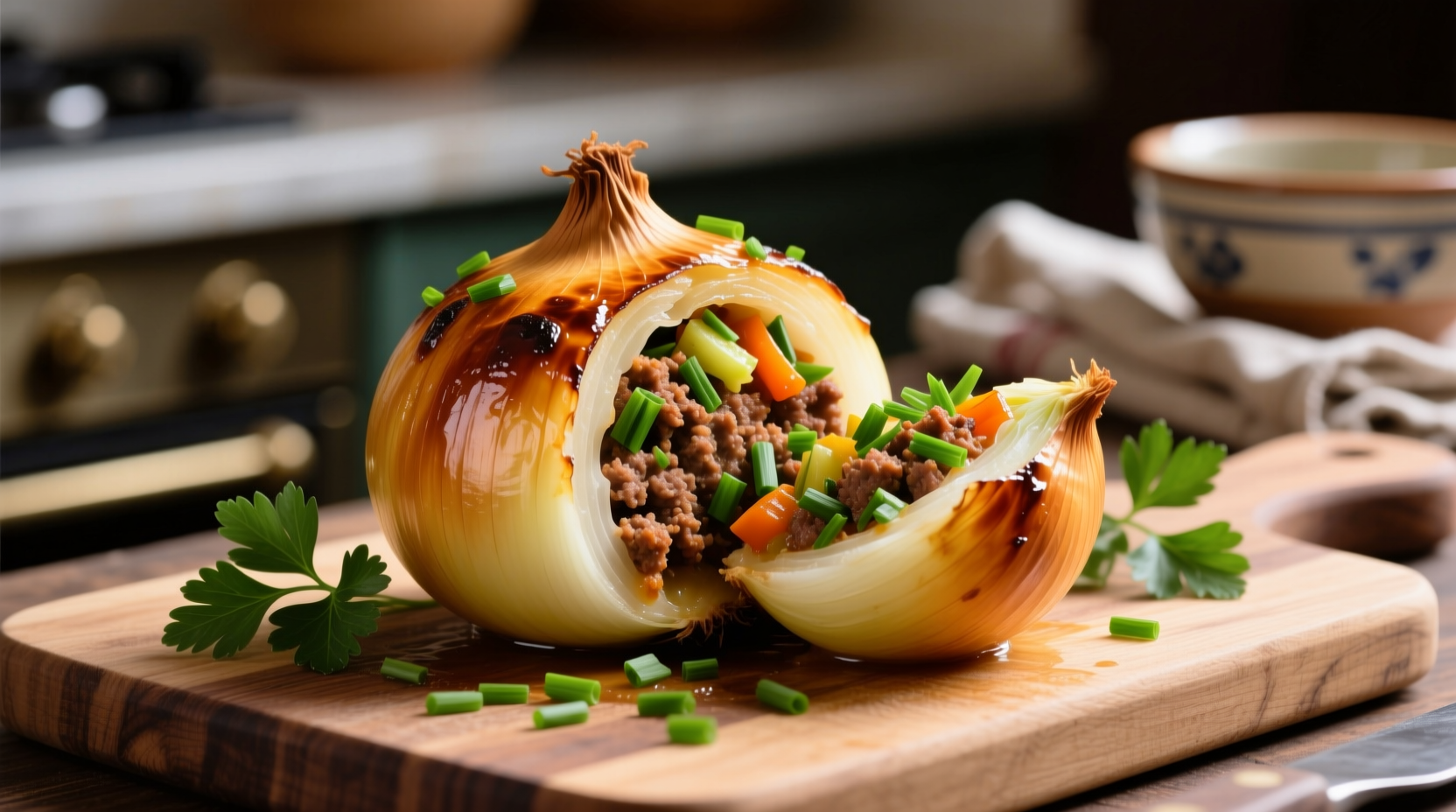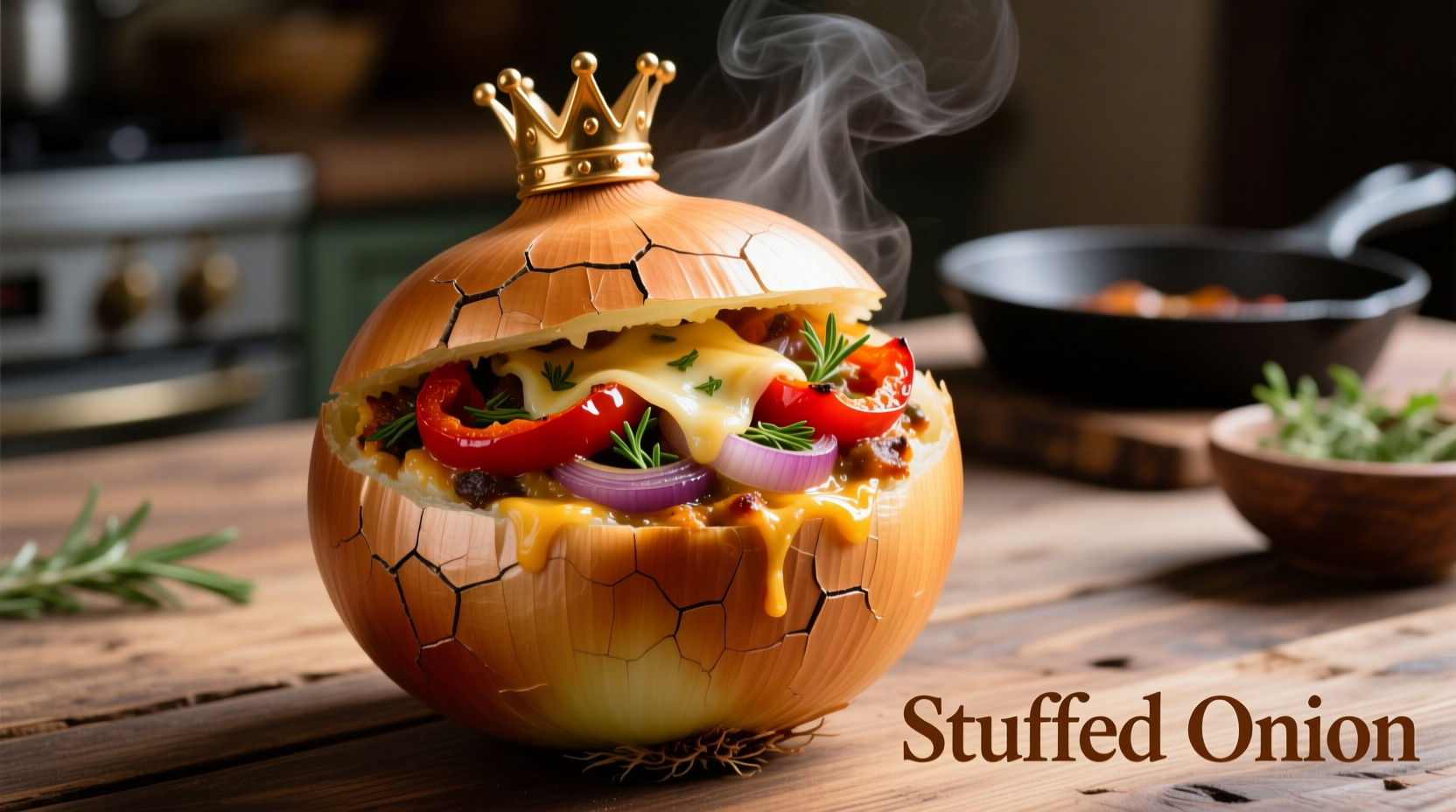For home cooks seeking to master this humble yet sophisticated dish, understanding the right onion varieties, stuffing combinations, and cooking techniques makes all the difference. Whether you're exploring traditional recipes or creating modern interpretations, stuffed onions provide a perfect canvas for culinary creativity while delivering exceptional flavor and texture.
The Global Journey of Stuffed Onions: A Culinary Timeline
Stuffed vegetables have ancient roots, with onions featuring prominently in early culinary traditions. Historical evidence shows stuffed vegetables appearing in:
| Era | Region | Development |
|---|---|---|
| 300 BCE | Mesopotamia | Earliest documented stuffed vegetables using available produce |
| 1st Century CE | Roman Empire | Apicius' cookbook mentions stuffed vegetables with herbs and meats |
| 15th Century | Ottoman Empire | Yalangi (stuffed vegetables) becomes refined palace cuisine |
| 18th Century | Eastern Europe | Onions stuffed with meat appear in Ukrainian and Polish cookbooks |
| 20th Century | Global | Vegetarian and vegan variations emerge worldwide |
This culinary evolution demonstrates how stuffed onions adapted to local ingredients and cooking traditions while maintaining their essential preparation method. According to food historians at the Oxford Symposium on Food and Cookery, stuffed vegetables represent one of the most widespread culinary techniques across cultures, with onions being particularly valued for their ability to absorb surrounding flavors while maintaining structural integrity during cooking.
Selecting the Perfect Onion for Stuffing
Not all onions work equally well for stuffing. The ideal onion has:
- Sufficient size to hollow out while maintaining structure
- Thick walls that won't disintegrate during cooking
- Flavor profile that complements the stuffing ingredients
| Onion Type | Best For | Preparation Tip | Cooking Time |
|---|---|---|---|
| Yellow Storage Onions | Most traditional recipes | Parboil 5 minutes before hollowing | 45-60 minutes |
| Red Onions | Colorful presentations | Use smaller varieties for individual portions | 35-50 minutes |
| White Onions | Mexican-inspired fillings | Soak in ice water to reduce sharpness | 40-55 minutes |
| Large Pearl Onions | Appetizers or side dishes | Blanch to remove skins easily | 25-40 minutes |
According to agricultural research from Cornell University's Food Science Department, yellow onions contain higher sugar content that caramelizes beautifully during baking, creating complex flavor compounds that enhance both the onion itself and the stuffing. This Maillard reaction is particularly pronounced when onions are cooked slowly at moderate temperatures (325-350°F).
Mastering the Stuffed Onion Technique: Step-by-Step
Creating perfect stuffed onions requires attention to several critical steps:
1. Preparing the Onions
Begin by trimming the top 1/4 inch of the onion and removing the root end. Carefully hollow out the center using a small knife or melon baller, leaving a 1/4-inch thick wall. Save the removed onion pieces for your filling. Parboiling for 3-5 minutes makes hollowing easier while preserving structure.
2. Creating Flavorful Fillings
The filling should complement the onion's natural sweetness while providing textural contrast. Traditional combinations include:
- Meat-based: Ground beef or lamb with rice, herbs, and tomato
- Vegetarian: Quinoa, mushrooms, and walnuts with Middle Eastern spices
- Cheese-focused: Feta, breadcrumbs, and fresh herbs for Mediterranean style
When developing fillings, consider the moisture content. Too much liquid causes the onion to collapse, while too little creates a dry result. The University of California Cooperative Extension recommends maintaining a 3:1 ratio of solid to liquid ingredients in stuffings for optimal texture.
3. Cooking Methods Compared
Different cooking approaches yield distinct results:
| Method | Best Results | Time Required | Moisture Control |
|---|---|---|---|
| Baking | Caramelized exterior, firm texture | 45-60 minutes | Place in baking dish with 1/4" broth |
| Braising | Tender throughout, rich flavor | 60-90 minutes | Cover with broth halfway up onions |
| Slow Cooking | Extremely tender, hands-off | 3-4 hours | Add minimal liquid (1/4 cup per onion) |
4. Achieving Perfect Doneness
Stuffed onions are done when:
- The onion walls are tender when pierced with a knife but still hold their shape
- The filling reaches 165°F internally for meat fillings
- The top shows golden brown edges
Resting for 10-15 minutes after cooking allows flavors to meld and makes serving easier. As noted in the Journal of Culinary Science & Technology, this resting period enables starches in grain-based fillings to fully absorb surrounding moisture, preventing a soggy texture.

Cultural Variations Worth Exploring
Stuffed onions appear in remarkably diverse forms across global cuisines:
Middle Eastern Yalangi
In Lebanon and Syria, onions are stuffed with spiced lamb, pine nuts, and rice, then simmered in a tangy tomato-lemon broth. The addition of pomegranate molasses creates a distinctive sweet-sour profile that balances the onion's natural bitterness.
Eastern European Holubtsi
Ukrainian and Polish versions often feature onions stuffed with a mixture of ground meat, buckwheat, and mushrooms, served with sour cream. These hearty preparations reflect the region's agricultural traditions and cold climate cooking needs.
Mediterranean Style
Greek and Turkish variations frequently incorporate feta or halloumi cheese, fresh herbs, and lemon zest, creating lighter summer-friendly dishes that showcase seasonal produce.
Troubleshooting Common Stuffed Onion Problems
Even experienced cooks encounter challenges with stuffed onions. Here's how to solve the most frequent issues:
Onions Falling Apart During Cooking
Cause: Overcooking or using onions with thin walls
Solution: Choose larger, firmer onions and reduce cooking time. Parboiling for 3-5 minutes before stuffing helps maintain structure.
Soggy or Waterlogged Fillings
Cause: Excess moisture in the filling or cooking liquid
Solution: Drain cooked rice or grains thoroughly. Use minimal cooking liquid and consider adding breadcrumbs to absorb excess moisture.
Undercooked Onions with Done Filling
Cause: Insufficient cooking time for the onion itself
Solution: Parboil onions before stuffing, or cover with foil during initial cooking phase to steam the onions, then uncover to finish cooking.
Serving Suggestions for Maximum Impact
Elevate your stuffed onions with these professional presentation techniques:
- Place on a bed of complementary grains like couscous or quinoa to catch flavorful juices
- Garnish with fresh herbs that match your filling's flavor profile
- Add a drizzle of complementary sauce just before serving (yogurt sauce for Middle Eastern styles, tomato broth for Eastern European)
- Serve with a contrasting side like a crisp green salad to balance the richness
According to culinary research published by the International Association of Culinary Professionals, the visual presentation of stuffed vegetables significantly impacts perceived flavor intensity, with well-presented dishes rated as 22% more flavorful than identical but poorly presented counterparts.
Stuffed Onions: Nutritional Benefits Beyond Flavor
Beyond their culinary appeal, stuffed onions offer notable nutritional advantages:
- Onions provide quercetin, a powerful antioxidant with anti-inflammatory properties
- The cooking process increases bioavailability of certain nutrients
- When prepared with whole grains and lean proteins, they create balanced meals
The American Journal of Clinical Nutrition notes that cooking onions with healthy fats (like olive oil) enhances the absorption of fat-soluble compounds while preserving most water-soluble nutrients through the relatively short cooking times required for stuffed preparations.
Perfecting Your Stuffed Onion Technique: Pro Tips
Take your stuffed onions from good to exceptional with these professional techniques:
- Flavor layering: Sauté the hollowed onion pieces with your filling ingredients to incorporate their flavor
- Texture contrast: Add toasted nuts or seeds to fillings for crunch against the soft onion
- Moisture control: Place a small piece of bread inside the onion before stuffing to absorb excess liquid
- Flavor infusion: Add citrus zest or fresh herbs to the cooking liquid for subtle flavor enhancement
For vegetarian versions, mushroom broth instead of meat stock creates deep umami notes without animal products. The Culinary Institute of America's research shows that combining mushrooms with onions activates synergistic flavor compounds that mimic meaty richness through natural chemical reactions.
FAQs About Stuffed Onions
Here are answers to common questions about preparing this versatile dish:











 浙公网安备
33010002000092号
浙公网安备
33010002000092号 浙B2-20120091-4
浙B2-20120091-4